2015-11-20 Fri
■ #2398. 文字の系統 (3) [grammatology][family_tree][flash][mindmap]
文字の系統図はすでに 「#423. アルファベットの歴史」 ([2010-06-24-1]),「#1822. 文字の系統」 ([2014-04-23-1]),「#1834. 文字史年表」 ([2014-05-05-1]),「#1849. アルファベットの系統図」 ([2014-05-20-1]) でいろいろ示してきたが,たいてい言語に関わる系統図は,論者の数だけあるといっても過言ではない.
言語そのものの系統関係を示す図も,様々な理論的な問題を含んでいるが,文字の系統図はさらに難しい.例えば,1446年に人工的に(したがって極めて合理的に)創作され,李朝第4代世宗によって「訓民正音」の名で公布されたハングルは,新たに生み出された文字体系であるという点で,主たる歴史的な文字体系のいずれにも属さないはずである.しかし,創作にあたって悉曇を参考としつつ,漢字とアルファベットなどからインスピレーションを得て創案された可能性が高いという点を斟酌して,多くの系統図では,それらの系列に連なるものとして表現されることが多いのである.しかし,実際のところ,そのインスピレーションが何だったかのは決定しがたく,系統図を編む者の推測が多分に含まれている.一方,日本語の仮名は,漢字からの漸次的な発達であることが文献学的,古文書学的にかなり正確に確かめうるので,系統図上,漢字のもとに連ねても異論は生じない.文字体系によって,このような歴史的な発達の確かさに差があるために,論者によって異なる系統図が描かれるのである.
さて,そこで今回は『世界の文字の図典』 (p. 5) の文字系統図をもとに,マインドマップ風に改変したものを示したい.下図をクリックして大画像をご覧ください.あるいは,ノードを開閉できるFLASH 版もどうぞ.なお,見やすくするために配列などを相当いじっているので,原典ほどの信頼度はないことを前提に,手軽な参照用としてのご利用をお願いします.
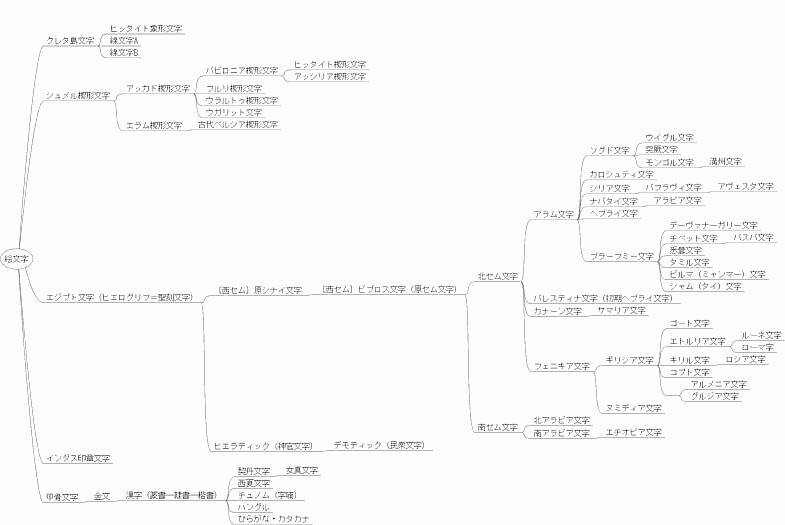
・ 『世界の文字の図典 普及版』 世界の文字研究会(編),吉川弘文館,2009年.
2015-02-18 Wed
■ #2123. 言語変化の切り口 [language_change][causation][diachrony][linguistics][flash][methodology][mindmap]
言語変化について様々に論じてきたが,言語変化を考察する上での諸々の切り口,研究する上で勘案すべき種々のパラメータを整理してみたい.言語にとって変化が本質的であるならば,言語変化研究こそが言語研究の革新ともいえるはずである.
以下に言語変化の切り口を,本ブログ内へのリンクを張りつつ,10項目立てで整理した.マインドマップ風にまとめた画像,PDF,あるいはノードを開閉できるFLASHもどうぞ.記事末尾の書誌は,最も重要な3点のみに限った.以前の同様の試みとして,「#729. 言語変化のマインドマップ」 ([2011-04-26-1]) も参照.
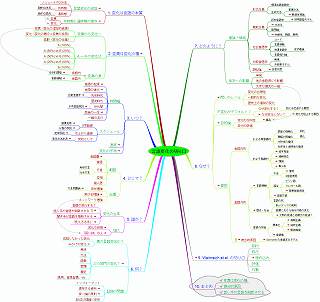
1. 変化は言語の本質
言語変化の逆説
ソシュールの2分法
共時態
静的な体系
通時態
動的な混沌
共時態と通時態の接点
変異
変化
2. 変異は変化の種
変異から変化へ
変異(変化の潜在的資源)
変化(変化の履行=変異の採用)
拡散(変化の伝播)
A → B の変化は
A (100%)
A (80%) vs B (20%)
A (50%) vs B (50%)
A (20%) vs B (80%)
B (100%)
変異の源
言語内
体系的調整
言語外
言語接触
3. いつ?
時間幅
言語の起源
言語の進化
先史時代
比較言語学
歴史時代
世代間
子供基盤仮説
話者の一生
一瞬の流行
スケジュール
S字曲線
語彙拡散
分極の仮説
右上がり直線
定率仮説
突如として
青年文法学派
速度
変化の予測
4. どこで?
範囲
言語圏
言語
方言
地域方言
社会方言
位相
個人語
伝播
波状理論
方言周圏論
飛び石理論
ネットワーク理論
5. 誰が?
変化の主体
言語が変化する?
話し手が言語を刷新させる
聞き手が言語を刷新させる
「見えざる手」
個人
変化の採用
「弱い絆」の人
6. 何?
真の言語変化か?
成就しなかった変化
みかけの変化
どの部門の変化?
意味
文法
語彙
音韻
書記
語用,言語習慣,etc.
証拠の問題
インフォーマント
現存する資料
斉一論の原則
記述は理論に依存
7. どのように?
理論・領域
形式主義
構造主義言語学
生成文法
普遍文法
最適性理論
機能主義
認知言語学
使用基盤モデル
文法化
語用論
余剰性,頻度,費用
社会言語学
コード
言語接触
地理言語学
波状理論
言語相対論
比較言語学
再建
系統樹モデル
類型論
含意尺度
体系への影響
単発
他の言語項にも影響
大きな潮流の一端
8. なぜ?
問いのレベル
変化の合理性
一般的な変化
歴史上の個別の変化
不変化がデフォルト?
なぜ変化する?
変化を促進する要因
なぜ変化しない?
変化を阻止する要因
目的論
変化の方向性
偏流
変化の評価
要因
言語内的
およそ無意識的
調音の簡略化
同化
聴解の明確化
異化
対称性の確保
効率性と透明性の確保
およそ意識的
綴字発音
過剰修正
類推
異分析
言語外的
言語接触
干渉
借用
2言語使用
混合
ピジン語
クレオール語
基層言語仮説
言語交替
言語の死
歴史・社会
新メディアの発明
語彙における指示対象の変化
文明の発達と従属文の発達?
言語の評価
標準化
規範主義
純粋主義
監視機能
言語権
複合的原因
Samuels の言語変化モデル
9. Weinreich et al. の切り口
制約
移行
埋め込み
評価
作動
10. まとめ
変異は変化の種
複合的原因
話し手が言語を刷新させる
・ Samuels, M. L. Linguistic Evolution with Special Reference to English. London: CUP, 1972.
・ Smith, Jeremy J. An Historical Study of English: Function, Form and Change. London: Routledge, 1996.
・ Weinreich, Uriel, William Labov, and Marvin I. Herzog. "Empirical Foundations for a Theory of Language Change." Directions for Historical Linguistics. Ed. W. P. Lehmann and Yakov Malkiel. U of Texas P, 1968. 95--188.
2014-11-25 Tue
■ #2038. Fennell の英語史概説書の目次 [historiography][hel_education][toc][flash]
「#2007. Gramley の英語史概説書の目次」 ([2014-10-25-1]) に続き,英語史概説書の目次を挙げて,英語史 (a history of English) を数分で俯瞰するというシリーズの第2弾.Fennell (2001) は,本ブログでもたびたび参照してきた英語史概説書であり,歴史社会言語学的なアプローチに特徴がある.ある書評を読むと,"A Sociolinguistic Approach" という副題の割には,とりわけ古い時代における社会言語学的な扱いは弱く,体系的でもないという.一方で,最後の3章,後期近代英語以降の各章では社会言語学的な洞察が光っており,読むに値するという評価がある.私もおよそこの評価に同意する.新しい洞察がどれだけあるかといえば必ずしも多くはないかもしれないが,近代以前の時代についても社会言語学的に興味深い話題をいくつか提供しており,社会言語学的に英語史を眺めるとどうなるかという試みとしてはよいのではないかと好意的に見ている.社会言語学寄りとはいえ伝統的な構造言語学的な記述も多いので,その他の定評のある英語史概説書を1, 2冊読んだ上で読むのに適するのではないか.ノードの開閉もできる Flash 版ももどうぞ.
1 Introduction
1.1 The Time Periods of English
1.2 Language Change
1.3 Sources of Information on Language Change
1.4 Linguistic Preliminaries
1.5 The Sounds of English, and Symbols Used to Describe Them
1.5.1 Consonants
1.5.2 Vowels
1.5.2.1 Monophthongs
1.5.2.2 Diphthongs
1.6 Structure of the Book
2 The Pre-history of English
Timeline: The Indo-European Period
2.1 The Indo-European Languages and Linguistic Relatedness
2.1.1 The Beginnings
2.1.2 The Development of Historical Linguistics
2.1.3 Genetic Relatedness
2.2 Linguistic Developments: The Indo-European Language Family
2.2.1 Family-Tree Relationships
2.2.2 The Indo-European Family
2.2.2.1 Indo-Iranian
2.2.2.2 Armenian
2.2.2.3 Albanian
2.2.2.4 Balto-Slavonic
2.2.2.5 Hellenic
2.2.2.6 Italic
2.2.2.7 Celtic
2.2.2.8 Germanic
2.3 From Indo-European to Germanic
2.3.1 Prosody
2.3.2 The Consonant System: Sound Shifts
2.3.2.1 Grimm's Law
2.3.2.2 Verner's Law
2.3.2.3 The Second Consonant Shift
2.3.3 The Vowel System
2.3.4 Morphology
2.3.5 Syntax
2.3.6 Lexicon
2.3.7 Semantics
2.3.8 Indo-European/Germanic Texts
2.3.9 Neogrammarians, Structuralists and Contemporary Linguistic Models
2.4 Typological Classification
2.4.1 Universals
2.4.1.1 Syntactic Universals
2.4.2 Morphological Typology
2.5 Sociolinguistic Focus. The Indo-European Tribes and the Spread of Language. Language Contact and Language Change. Archaeological Linguistics
2.5.1 Language Contact
2.5.2 Archaeological Linguistics
2.6 Conclusion
3 Old English
Timeline: The Old English Period
3.1 Social and Political History
3.1.1 Britain before the English
3.1.2 The Anglo-Saxon Invasions
3.1.3 Anglo-Saxon Influence
3.1.4 Scandinavian Influence
3.2 Linguistic Developments: The Sounds, Structure and Typology of Old English
3.2.1 The Structure of Old English
3.2.1.1 OE Consonants
3.2.1.2 Vowels: from Germanic to Old English
3.2.1.3 Old English Gender
3.2.1.4 Inflection in Old English
3.2.1.5 Old English Syntax
3.2.1.6 Old English Vocabulary
3.3 Linguistic and Literary Achievements
3.3.1 Texts
3.3.1.1 Prose
3.3.1.2 Poetry
3.4 The Dialects of Old English
3.5 Sociolinguistic Focus
3.5.1 Language Contact
3.5.1.1 Latin and Celtic
3.5.1.2 The Scandinavians
4 Middle English
Timeline: The Middle English Period
4.1 Social and Political History
4.1.1 Political History: The Norman Conquest to Edward I
4.1.2 Social History
4.1.2.1 The Establishment of Towns and Burghs and the Beginnings of Social Stratification
4.2 Linguistic Developments: Middle English Sounds and Structure, with Particular Emphasis on the Breakdown of the Inflectional System and its Linguistic Typological Implications
4.2.1 Major Changes in the Sound System
4.2.1.1 The Consonants
4.2.1.2 Consonant Changes from Old to Middle English
4.2.1.3 Vowels in Stressed Syllables
4.2.1.4 Vowels in Unstressed Syllables
4.2.1.5 Lengthening and Shortening
4.2.1.6 Summary Table of Vowel Changes from Old to Middle English
4.2.1.7 The Formation of Middle English Diphthongs
4.2.2 Major Morphological Changes from Old to Middle English
4.2.2.1 Loss of Inflections
4.2.2.2 Other Changes in the Morphological System
4.2.2.3 Verbs
4.2.3 Middle English Syntax
4.2.3.1 Word Order
4.2.4 The Lexicon: Loan Words from French
4.2.4.1 Numbers and Parts of the Body
4.2.4.2 Two French Sources
4.3 Middle English Dialects
4.3.1 Linguistic and Literary Achievements
4.3.1.1 Middle English Literature
4.3.2 Language
4.3.3 Genre
4.4 Sociolinguistic Focus: Social Stratification, Multilingualism and Dialect Variation. Language Contact: The Myth of Middle English Creolization
4.4.1 English Re-established
4.4.1.1 Language and the Rise of the Middle Class
4.4.2 The Development of Standard English
4.4.2.1 The Evolution of ME 'Standard' English
4.4.3 Middle English Creolization: Myth?
4.4.3.1 Definitions
4.4.3.2 Pidgins and Creoles in England?
4.5 Conclusion
5 Early Modern English
Timeline: The Early Modern English Period
5.1 Social and Political History
5.1.1 Historical and Political Background
5.1.1.1 Internal Instability and colonial Expansion
5.2 Linguistic Developments: The Variable Character of Early Modern English
5.2.1 Phonology
5.2.1.1 Consonants
5.2.1.2 Vowels
5.2.1.3 The Great Vowel Shift
5.2.2 Morphology
5.2.2.1 Nouns
5.2.2.2 Pronouns
5.2.2.3 Adjectives and Adverbs
5.2.2.4 Verbs
5.2.2.5 The Spread of Northern Forms
5.2.3 Syntax
5.2.3.1 Periphrastic do
5.2.3.2 Progressive Verb Forms
5.2.3.3 Passives
5.2.4 Sample Text
5.2.5 Vocabulary
5.2.6 The Anxious State of English: The Search for Authority
5.2.6.1 Dictionaries and the Question of Linguistic Authority: Swift's and Johnson's View of Language
5.3 Linguistic and Literary Achievement
5.4 Sociolinguistic Focus
5.4.1 Variation in Early Modern English
5.4.2 Standardization
5.4.2.1 The Printing Press
5.4.2.2 The Renaissance and the Protestant Reformation
5.4.2.3 English Established
5.4.3 The Great Vowel Shift
5.4.3.1 Phonological Change
5.4.4 Case Study: Power and Solidarity Relations in Early Modern English
5.5 Conclusion
6 Present-Day English
Timeline: Present-Day English
Introduction
6.1 Social and Political History
6.1.1 The Age of Revolutions, Wars and Imperialism
6.1.2 Urbanization, Industrialization and Social Stratification
6.2 Linguistic Developments
6.2.1 Morphology and Syntax
6.2.1.1 Morphology
6.2.1.2 Syntax
6.2.2 The Lexicon
6.2.2.1 Colonialism, Contact and Borrowings
6.2.2.2 Neologisms
6.2.2.3 Illustrative Texts
6.3 Modern English Dialects
6.3.1 Traditional Dialects
6.3.2 Modern Dialects
6.3.3 Received Pronunciation (RP): The Social Background
6.3.3.1 Characteristics of RP
6.3.4 RP, Estuary English and 'the Queen's English'
6.4 Sociolinguistic Focus: English in Scotland, Ireland and Wales --- Multilingualism in Britain
6.4.1 English in the British Isles
6.4.1.1 English in Scotland
6.4.1.2 English in Wales
6.4.1.3 English in Ireland
6.4.2 Immigrant Varieties of English in Britain
6.4.2.1 Immigration to Britain in the PDE Period
6.4.2.2 Colonial Immigration and Language
7 English in the United States
Timeline: America in the Modern Period
7.1 Social and Political History
7.1.1 Settlement and Language
7.1.2 Settlement by Region
7.1.2.1 The Original Thirteen Colonies
7.1.2.2 The Middle West
7.1.2.3 The South and West
7.2 The Development of American English
7.2.1 The Strength and maintenance of Dialect Boundaries
7.2.2 How, Why and When American English Began to Diverge from British English
7.2.2.1 Physical Separation
7.2.2.2 The Different Physical Conditions Encountered by the Settlers
7.2.2.3 Contact with Immigrant Non-Native Speakers of English
7.2.2.4 Developing Political Differences and the Growing American Sense of National Identity
7.3 Language Variation in the United States
7.3.1 Uniformity and Diversity in Early American English
7.3.2 Regional Dialect Divisions in American English
7.3.2.1 The Lexicon
7.3.2.2 Phonology: Consonants
7.3.2.3 Phonology: Vowels
7.3.3 Social and Ethnic Dialects
7.3.3.1 Social Class and Language Change
7.3.3.2 Ethnicity
7.3.3.3 African-American Vernacular English
7.3.3.4 Traditional Dialects and the Resistance to Change
8 World-Wide English
Timeline: World-Wide English
8.1 Social and Political History: The Spread of English across the Globe
8.1.1 British Colonialism
8.1.1.1 Canada
8.1.1.2 The Caribbean
8.1.1.3 Australia
8.1.1.4 New Zealand
8.1.1.5 South Africa
8.1.1.6 South Asia
8.1.1.7 Former Colonial Africa: West Africa
8.1.1.8 East Africa
8.1.1.9 South-East Asia and South Pacific
8.1.2 An Overview of the Use of English throughout the World
8.2 English as a Global language
8.2.1 The Industrial Revolution
8.2.2 American Economic Superiority and Political Leadership
8.2.3 American Technological Domination
8.2.4 The Boom in English language Teaching
8.2.5 The Need for a Global Language
8.2.6 Structural Considerations
8.2.7 Global and at the Same Time Local
8.3 English as a Killer Language
8.3.1 Language Death
8.3.2 Language and Communication Technology
8.4 The Future of English
・ Fennell, Barbara A. A History of English: A Sociolinguistic Approach. Malden, MA: Blackwell, 2001.
2014-11-10 Mon
■ #2023. England の現代英語方言区分 (3) --- Modern Dialects [dialect][bre][flash][family_tree][map]
「#1029. England の現代英語方言区分 (1)」 ([2012-02-20-1]) 及び「#1030. England の現代英語方言区分 (2)」 ([2012-02-21-1]) で現代イングランドの英語区分を示した.そこで示したのはいわゆる伝統方言 (Traditional Dialects) である.伝統方言は20世紀半ばにはすでに減退しており,21世紀の現在ではその減退が続き,消滅しかかっているといっても過言ではない.一方で,新しいタイプの方言,いわゆる現代方言 (Modern Dialects) が取って代わって若い世代に影響力を及ぼしており,方言としては主流のタイプとなっている.このイングランドの Modern Dialects は,日本語方言学者の井上史雄先生が日本語の伝統方言を置換しつつあるものとして提起した「新方言」に,いくつかの点で比較され,興味深い.
Trudgill (5--6) は,Traditional Dialects に対置するものとしての Modern Dialects あるいは Mainstream Dialects という新種の方言に注目し,その区別を次のように表現している(伝統方言の定義については,[2012-02-20-1]の記事の引用を参照).
Mainstream Dialects, on the other hand, include both the Standard English Dialect and the Modern Nonstandard Dialects. Most native English speakers speak some variety of Mainstream Dialect. These dialects are associated with native speakers outside the British Isles, especially in recently settled areas which speak mixed colonial dialects, such as Australia and most of America and Canada. In Britain, they are particularly associated with those areas of the country from which Standard English originally came --- the southeast of England; with most urban areas; with places which have become English-speaking only relatively recently, such as the Scottish Highlands, much of Wales, and western Cornwall; with the speech of most younger people; and with middle- and upper-class speakers everywhere. The mainstream Modern Nonstandard Dialects differ much less from Standard English and from each other, and are often distinguished much more by the pronunciation --- their accent --- than by their grammar.
以下に示すのは,Trudgill (66--67) による Modern Dialects の区分である.ノードの開閉もできる Flash 版も作成しみたのでこちらもどうぞ.
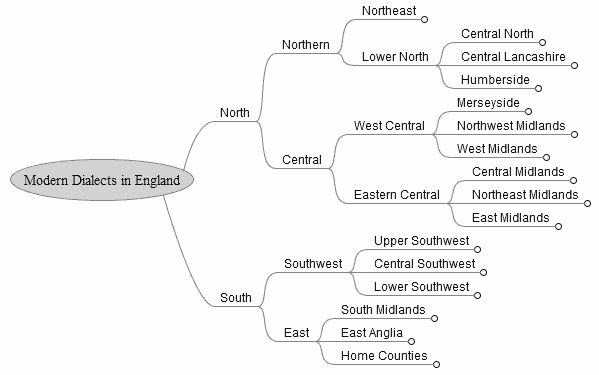 *
*
・ Trudgill, Peter. The Dialects of England. 2nd ed. Blackwell: Malden, MA: 2000.
2012-11-02 Fri
■ #1285. FLASHで英語史略年表 [timeline][history][flash][web_service][world_languages][loan_word][link]
マンチェスター大学の発信する,子供向け教育コンテンツを用意しているこちらのサイトのなかに,Timeline of English Language なるFLASHコンテンツを発見した.粗い英語史年表で,あくまで導入的な目的での使用を念頭に置いたものだが,話の種には使えるかもしれないので紹介しておく.
言語に関する他のコンテンツへのリンクは,こちらにある.次のものなどは,結構おもしろい.
・ World Language Map
・ Borrowing Game
簡易年表ということでいえば,A brief chronology of English なるものを見つけた.本ブログ内では,timeline を参照.
2012-06-16 Sat
■ #1146. インドヨーロッパ語族の系統図(Fortson版) [indo-european][family_tree][flash]
印欧語族の系統図や地図については,本ブログでも何度か触れてきた.
・ [2009-06-17-1]: 「#50. インドヨーロッパ語族の系統図をお遊びで」(Flash版)
・ [2010-07-26-1]: 「#455. インドヨーロッパ語族の系統図(日本語版)」(Flash版)
・ [2012-05-19-1]: 「#1118. Schleicher の系統樹説」
・ [2012-05-30-1]: 「#1129. 印欧祖語の分岐は紀元前5800--7800年?」
・ [2011-04-12-1]: 「#715. Britannica Online で参照できる言語地図」.特に現代における印欧諸語の地理的分布については Approximate locations of Indo-European languages in contemporary Eurasia を参照. *
上記に加えて,今回,新たに Fortson (10) の系統図を3種類の方法で再現してみる.もとより網羅的ではないが,これまでの系統図に比べれば詳しい.* 印のあるものは,死語,あるいは現代語の古い段階を表わす.
複数の印欧語系統図を示す意義は,研究者ごとに諸言語の分類や図の描き方の異なる点を強調することにより,言語の系統というものが絶対的なものではないことを確認する点にある.この点については,「#807. 言語系統図と生物系統図の類似点と相違点」 ([2011-07-13-1]) や「#1118. Schleicher の系統樹説」 ([2012-05-19-1]) も参照.
・ PNG画像版の系統図(=以下の画像の拡大版)
・ ノードを開閉できるFLASH版の系統図
・ ノードを開閉できるHTML版のリスト型系統図
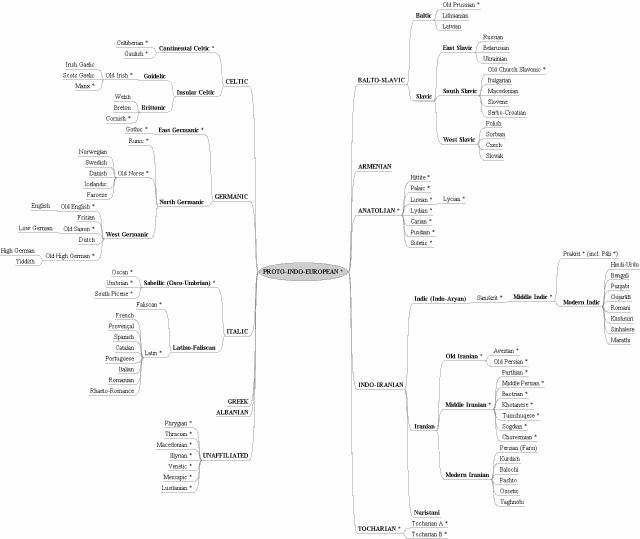
・ Fortson IV, Benjamin W. Indo-European Language and Culture: An Introduction. Malden, MA: Blackwell, 2004.
2012-02-22 Wed
■ #1031. 現代日本語の方言区分 [japanese][dialect][flash][family_tree][map]
この2日間の記事 ([2012-02-20-1], [2012-02-21-1]) で,イングランドにおける現代英語方言区分の概略を示したが,イングランドは相当に細かく区分されていることを改めて思い知らされた.
イングランドの国土は比較的狭いにもかかわらず,方言がこれほどまでに分化したことは,国土は広いが言語的には同質的とされるアメリカ英語と好対照をなす.アメリカでは,「#591. アメリカ英語が一様である理由」 ([2010-12-09-1]) や「#457. アメリカ英語の方言区分( Kurath 版)」 ([2010-07-28-1]) で話題にした通り,方言区分はずっと粗い.両者の差異は,英語が根付くことになった経緯,歴史の長さ,交通の発達,規範に対する意識など,様々な要因に帰せられる.
しかし,程度の差はあれ,方言の分化は言語にとって普遍的だ.イングランド同様に国土が狭いとされる日本の方言状況を顧みれば,よく理解できる.以下は,佐藤 (167) の方言区画図を再現したものである.
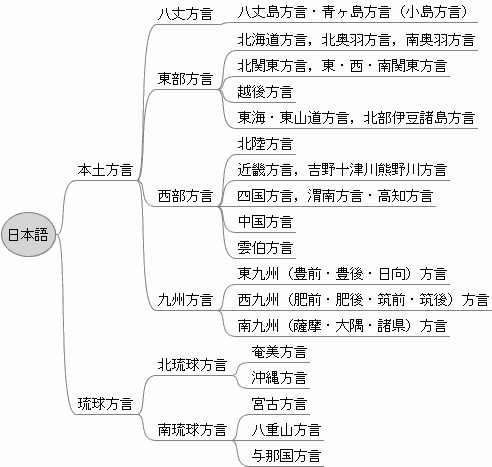 *
*
日本語を2分する大分水嶺は,本土方言と琉球方言のあいだの海のなかだが,次に大きな分水嶺は本州の東と西を分ける線だろう.新潟県の糸魚川と静岡県の浜名湖を結ぶ,くの字の線だ.明治政府の『口語法調査報告書』によると,「假ニ全國ノ言語區域ヲ東西ニ分タントスル時ハ大略越中飛彈美濃三河ノ東境ニ沿ヒテ其境界線ヲ引キ此線以東ヲ西部方言トスルコトヲ得ルガ如シ」とある(佐藤,p. 169--71).
・ 佐藤 武義(編著) 『展望 現代の日本語』 白帝社,1996年.
2012-02-20 Mon
■ #1029. England の現代英語方言区分 (1) [dialect][bre][flash][family_tree][map]
中英語の方言区分については,[2009-09-04-1]の記事「#130. 中英語の方言区分」で地図とともに取りあげた.今回は,England における現代英語の方言区分を示したい.
扱う方言の種類は,Traditional Dialect と呼ばれるもので,古英語や中英語からの方言区分の延長線上にあるものである.Trudgill (5) の説明を引用する.
Traditional Dialects are what most people think of when they hear the term dialect. They are spoken by a probably shrinking minority of the English-speaking population of the world, almost all of them in England, Scotland and Northern Ireland. They are most easily found, as far as England is concerned, in the more remote and peripheral rural areas of the country, although some urban areas of northern and western England still have many Traditional Dialect speakers. These dialects differ very considerably from Standard English, and from each other, and may be difficult for others to understand when they first encounter them.
England の Traditional Dialect の調査はヨーロッパの他の国よりも遅れたが,Orton, H. et al. Survey of English Dialects: The Basic Material. 4 vols. Leeds: E. J. Arnold, 1962--71. により1950年代以降の方言分布が明らかにされてきた.以下に示すのは,部分的に Survey に依拠した Trudgill (35) の区分である.13の方言区画へと区分されている.
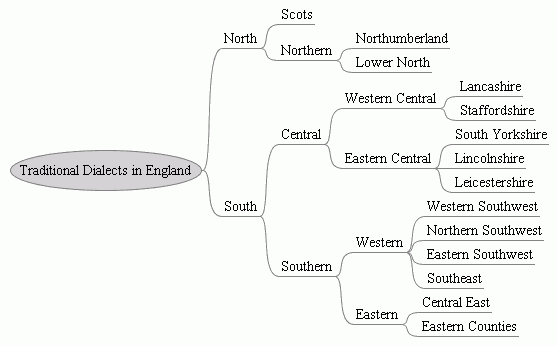 *
*
また,Trudgill (40, 44, 47) に従ってさらに下位区分した,ノードの開閉もできる Flash 版を作成したので,そちらもどうぞ.
イングランドの最も大きな方言区分は,South と North を分ける線だ.この線は Lancashire 海岸と the River Humber 河口を結んでおり,概ね古英語以来変わっていない.1600年以上続く大分水嶺である.
・ Trudgill, Peter. The Dialects of England. 2nd ed. Blackwell: Malden, MA: 2000.
2011-04-26 Tue
■ #729. 言語変化のマインドマップ [language_change][causation][linguistics][flash][methodology][mindmap]
大学の授業で英語史における具体的な言語変化を論じるにあたって,しばしば言語変化理論を概説する必要が生じるのだが,この学際的な分野を一望できる適切な資料がない.言語変化を扱う研究書の目次などが使えるのではないかと思っているが,探すよりも自分でまとめたほうが手っ取り早いと考えた.Bussmann の言語学辞典の "language change" の項を参照し,マインドマップを作成してみた.ノードを開閉できるFlash版もどうぞ.
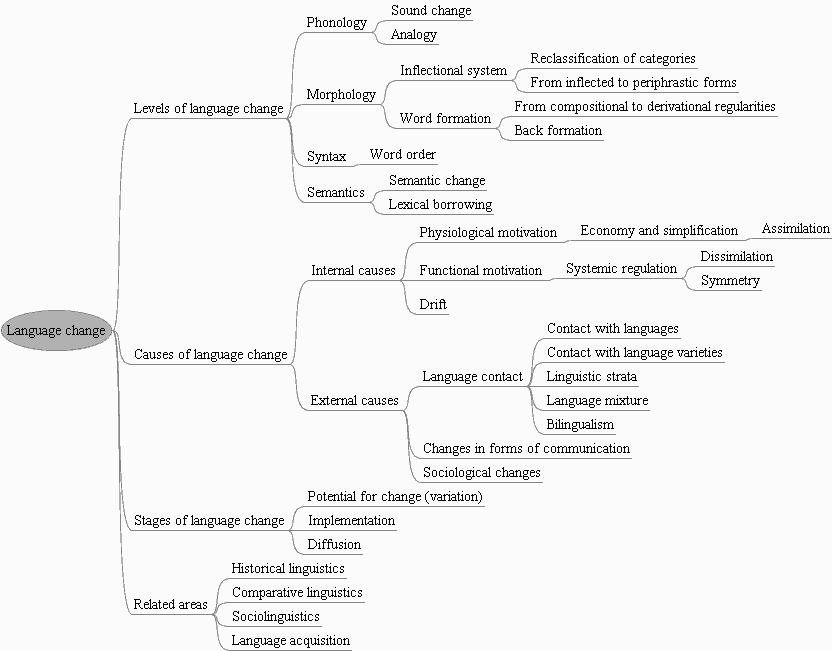
作成に当たっては,ほかに[2010-07-13-1]の記事「言語変化の原因」などを参照した.ゆくゆくは language_change の各記事をまとめて,マインドマップの改訂版を作りたいと思っている.ある意味で,このブログ全体を通じて言語変化に関する考察の目録を作ろうとしているとも言えるので,日々の書きためが肝心.
英語の言語変化理論に関するウェブ上の資料としては,Raymond Hickey's Studying the History of English の Language change が充実している.
・ Bussmann, Hadumod. Routledge Dictionary of Language and Linguistics. Trans. and ed. Gregory Trauth and Kerstin Kazzizi. London: Routledge, 1996.
2010-07-26 Mon
■ #455. インドヨーロッパ語族の系統図(日本語版) [indo-european][family_tree][flash]
[2009-06-17-1]でインドヨーロッパ語族の系統図を掲載したが,言語名を日本語表記とする改訂版を作成してみた.向かって左側が centum グループ,右側が satem グループ ( see [2009-08-05-1] ).合わせてノードを開閉できるFlash版も作ったので,戯れにどうぞ.
今回あらためて印欧語系統図を作成して分かったことは,参考書によって言語の所属や配置が異なる,言語名の列挙の仕方に方針がない,言語名の日本語表記に揺れがあるなど,未確定だったり不明だったりする点が多いということ.言語の系統というのは難しいものだと実感した ( see [2010-05-01-1] ) .
(図をクリックすると拡大)
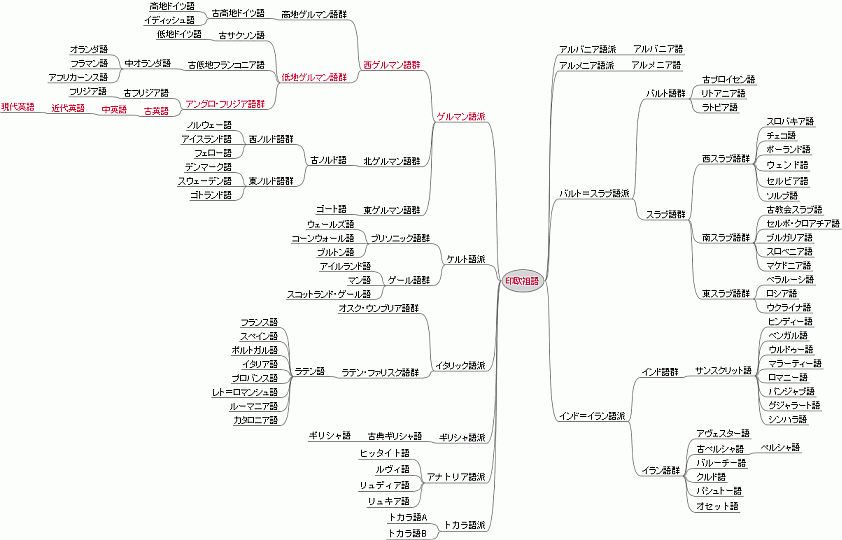
2010-03-16 Tue
■ #323. 英語史のイントロクイズ(2009年度版)の解答 [flash][quiz][hel_education]
昨日[2010-03-15-1]のクイズの解答は,こちらの Flash のスライドでどうぞ.(ファイルが500KB強とやや重いので,本記事には貼りつけなかった.直接,PDFのスライドとして落としたい方はこちらからどうぞ.)
スライドでは,各問題の次のページが解答(と補足)になっている.昨日も述べた通り,クイズ自体は荒っぽいし,数値も数年前のものでありアップデートされていないので,あくまで参考までに.クイズ作成に利用した参考資料はいくつかあるが,Graddol を参照することが多かった.
・ Graddol, David. The Future of English? The British Council, 1997. Digital version available at http://www.britishcouncil.org/learning-research-futureofenglish.htm.
2010-03-15 Mon
■ #322. 英語史のイントロクイズ(2009年度版) [flash][quiz][hel_education]
毎年度始め,英語史の初回の授業で以下のようなクイズを試している(全25問).かなり荒っぽいクイズではあるがそこそこ好評なので,1年ほど前に使用した2009年度版のクイズを以下に掲載する(全画面モードでどうぞ).直接,PDFのスライドとして落としたい方はこちらからどうぞ.答えは,明日の記事で.
2009-10-01 Thu
■ #157. foot の複数はなぜ feet か [plural][i-mutation][vowel][flash][sobokunagimon]
後期の授業が始まり,初回のガイダンスで使った小ネタです.全画面モードのほうが見やすいと思います.あるいは,PDFのスライドとして落としたい方はこちらからどうぞ.
2009-07-27 Mon
■ #91. なぜ一人称単数代名詞 I は大文字で書くか [palaeography][spelling][flash][punctuation][capitalisation][minim][personal_pronoun]
先日,前期の最終授業時に,話しの種にと思い紹介した内容.そのときに使用したスライドを本ブログに掲載してほしいと要望があったので,Flash 化した「Why Capital "I" ?」を載せてみた.下のスクリーンで映らない,あるいは PDF で見たいという方は,こちら.
本当は,写本から字体をいろいろ挙げ,実例で確認するといいのだろうが,省略.
2009-06-17 Wed
■ #50. インドヨーロッパ語族の系統図をお遊びで [indo-european][family_tree][flash][mindmap]
英語史のどの概説書でも見つけられる類のインドヨーロッパ語族(印欧語族)の系統図だが,マインドマップ風にアレンジしてみた.また,絵だけでは芸がないと思ったので,今回はこちらのページに Flash で遊べるものも作ってみた.クリックしてゆくと枝葉が展開するという仕掛け.
(図をクリックすると拡大)
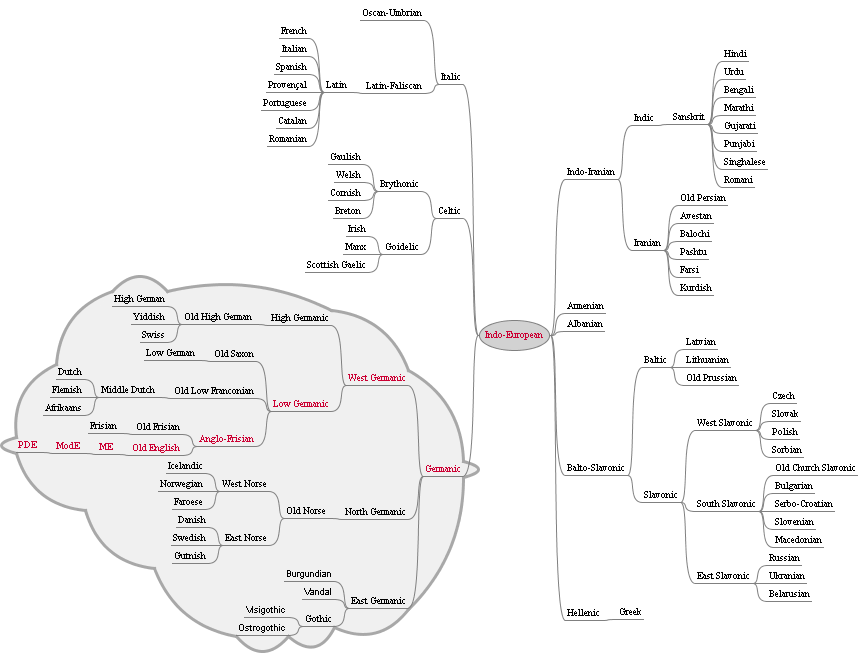
Powered by WinChalow1.0rc4 based on chalow